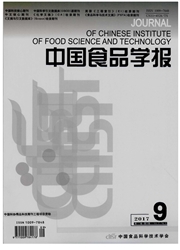

 中文摘要:
中文摘要:
以雨生红球藻粉为原料,采用有机溶剂法提取虾青素并对虾青素提取液稳定性进行研究。用响应面法优化提取工艺,采用Box-Behnken设计方法研究提取温度、提取时间、料液比及其交互作用对虾青素提取量的影响。试验结果表明:最佳提取条件为:提取温度51℃,提取时间42 min,料液比1∶640 g/m L,在此条件下提取率达92.04%。虾青素的性质不稳定,易分解,在贮存过程中受到多种因素的影响。当温度低于40℃时,虾青素提取液比较稳定;在太阳光及紫外光照射下,虾青素破坏严重;Zn^2+,Cu^2+,Fe^2+,Mg^2+,Na+和Ca^2+对虾青素提取液都有较大影响;而抗氧化剂VC,Na2SO3对虾青素有破坏作用,BHT对其稳定性保护作用效果不显著。在避光条件下冷藏保存并减少与金属离子的接触,可以减缓虾青素的降解。
 英文摘要:
英文摘要:
In this study, the extraction of astaxanthin from Haematococcus pluvialis was investigated by mixture organic solvents and the stability of astaxanthin were study. The response surface methodology was adopted in this paper and the Box-Behnken Design was applied to the study of the effects of extracting temperature, extracting time and liquid-material ratio. The experimental results showed that the best extraction conditions were: extracting temperature 51 ℃,extracting time 42 min and the ratio of material to liquid 1 ∶ 640. Under these conditions, the rate of astaxanthin is 92.04%. The property of astaxanthin was unstable and easy to be decomposed. The content of astaxanthin stabilized when temperature were lower than 40 ℃; the light of sun and UV could seriously damage astaxanthin; the metal ions of Zn^2+,Cu^2+, Fe^2+, Mg^2+, Na+and Ca^2+had huge impacts on the astaxanthin; however the antioxidant of VC and Na2SO3 could damage the astaxanthin and the BHT could barely protect astaxanthin from oxidation. The results indicated that the degradation of astaxanthin could be slow down with little metal ions under the condition of refrigeration in the dark..
 同期刊论文项目
同期刊论文项目
 同项目期刊论文
同项目期刊论文
 期刊信息
期刊信息
